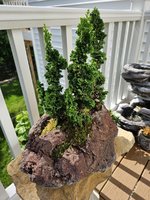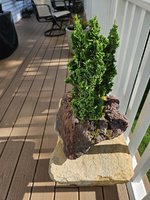Frozentreehugger
Masterpiece
For my taste I feel there are way to many low quality forests. I think you have the right idea . Assemble a forest out of trees . That gave been trained independent of each other . Also I think in the long run . It will be faster . At least to a quality finished product . Your tree would do very nicely as a forest edge specimen. Where the smaller trunk was reaching for light . Myself I don’t have a forest . But I’m drawn to the more radical . Or at least less sedate .All very good points,,, thanks for you time evaluating my tree. So the reason I potted the tree in the strainer was to basically to reduce the root ball. I've been playing around with the idea of making a forest composition or a mini landscape, something off the beaten path kinda thing.. but I don't have much room for another forest right now ,,so in the mean time I'm just training all my material for a future shallow pot. I say landscape because all the trees look different and a forest composition with 7 to 11 trees looking like stand alone trees wouldn't work conveniently. The possibility of buying new material that I style to look more Communal isn't out the question either tho. As far as where I want to take this newest tree I styled up,,I want it to look as convincing as possible to a real deciduous tree from say 50 to 25 yards away. I think this cultivar looks very much like a deciduous tree from a distance if styled correctly. The triple trunk feature would be nice if it did Mirror the main trunk more but I think it could still work if i can get it to look more like Individual trees stuck to the Dominant trunk..I do think I can pull it off convincingly with more time and growth developing. I tend to only style trees to look like a "bonsai "in the sense of first branch 1/4th the hight ,,second branch to the opposite and back branch next when the tree is screaming to be designed in that manner..




